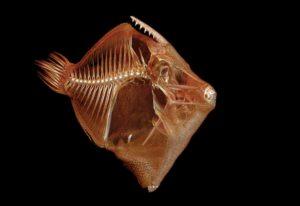
An obsessive/compulsive fantasy project that puts to shame those who only have 136 Pokémon to collect, this project is something that Dr. Summers has been working on for quite some time. In 2000 he was able to plead with a hospital to conduct a CT scan on a sting ray. The photos from that shoot might not have garnered the same publicity as the nude pics of Melania Trump, but they do hold the honor of being the first-ever CT scanned fish to grace the cover of a journal of biology.
Since then, Dr. Summers has been steadily amassing a collection of 3D scanned fish species in conjunction with hospitals, but found that each scan was still too costly, ranging from $500 to $2,000 a pop, to make his dream of an omni-specimen database into a reality. Unable to relinquish his vision, he instead raised $340,000 to purchase the Bruker SkyScan 1173 scanner that is now housed at the Friday Harbor Laboratories, and he makes the machine freely available to anyone interested in using it to scan their fish.
These aren’t just locally caught fish being slapped up on the bed; there is a requirement that the fish come from museum-accessioned collections. So far, he has managed to collect scans from 515 different species and the numbers are continuing to grow. Given that there are over 25,000 species of fish on our planet, it’s a good thing that it turns out he’s not the only one interested in this project. It’s an even better thing that he has developed methods for scanning multiple specimens at once. He does this by creating a rolled up bundle of the fish for scanning and then separating the data into individual fish after the scan is complete.
“We just made it a group effort to get everything done. Having this scanner has made it clear to me the incredible power of this system if you think about it the right way…The way transformative ideas do, these just instantly changed the way we think about scanning specimens. We went from ‘Is this possible?’ to scanning whole series of fishes quickly.”
Dr. Summers estimates that the fish scanning project will be completed in the next few years, and as the scans are finished, he is posting them online to Open Science Framework so they can be utilized by all who need them. Thoughts on this project? Let’s discuss the top further over in the 3D Scanning Fish Species forum at 3DPB.com.
[Source/Images: University of Washington]